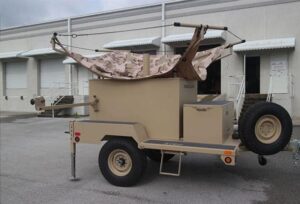Aerostat platforms provided by Lighter Than Air Systems Corp. (“LTAS”), a wholly owned subsidiary of World Surveillance Group Inc. (OTCQB: WSGI), a developer of lighter-than-air aerostats and unmanned aerial systems, will be used in the U.S. Army’s Network Integration Experiment (“NIE”) 14.1 set to take place at the U.S. Army White Sands Missile Range in New Mexico during October and November. The two complete, turn-key trailer-mounted aerostat launcher systems previously delivered to the U.S. Army Space and Missile Defense Command (“SMDC”) enable persistent, on-demand beyond-line-of-sight communications in support of ground forces maneuvers.
The NIE is a series of semi-annual, soldier-led evaluations designed to further integrate, mature and rapidly progress the Army’s tactical communications network. NIE 14.1, the sixth in the series of semi-annual field exercises, will focus on balancing the live, virtual and constructive mix of communications to achieve a higher-quality evaluation of existing and prototype products in a cost-constrained environment. NIE serves as a principal driver of change in the Army — such in-field evaluation and integration events drive requirements, field recommendations and procurement.
Earlier this year, LTAS delivered two complete, trailer-mounted aerostat launcher systems to the SMDC Battle Lab, who referred to them as the Winch Aerostat Small Platform (“WASP”). The WASP is a self-contained tactical aerostat that provides enhancements where existing systems are limited, particularly in complex terrain. The WASP system is designed to elevate a secure communications package to increase communications coverage, reduce the need to position retransmissions forward, and enable operational dispersion.
Glenn D. Estrella, WSGI’s President and CEO, stated, “We are honored that our LTAS aerostat systems are participating in this significant Army in-field integration experiment and firmly believe the aerostat systems can assist in providing a critical capability to soldiers who require constant communications. The integration of our systems into the Army’s communications network further supports our vision that our aerostat systems can quickly provide critical communications for military missions, disaster recovery efforts, and local and state operations.”



















